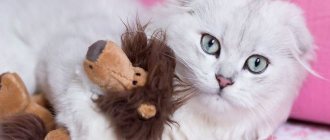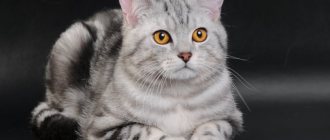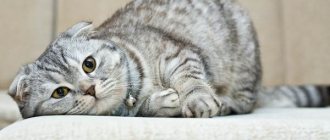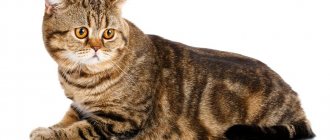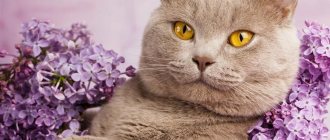The Scottish Straight cat (also called Scottish Straight) looks like a British cat, but they deserve to be called Scottish. These creatures are very balanced and extremely loyal to their owners.
Babies of this breed will bring many pleasant surprises to those who decide to have them, since it has long been believed that these cats, with their unique character, become guarantors of peace and harmony at home. This is interesting - Scottish fold kittens, character and care.
Brief history of the breed
The homeland of the Scottish Straight is Scotland, and the ancestor is considered to be a cat named Susie, who had unusual folded ears. Breeders tried their best to fix the mutational gene for lop ears in the breed. And to give a pretty appearance, they additionally used Persians, Burmese, British and American Shorthairs. As a result, the efforts of the breeders were crowned with success, and a fold-eared cat with a round head and large eyes was born. The breed was called the Scottish Fold and quickly gained popularity.
True, it soon became clear that when two lop-eared individuals are crossed, sick offspring are born. To improve health, folds began to be mated with straight-eared cats. In the litters from such “marriages” there were approximately the same number of fold-eared and straight-eared kittens. Despite the minimal differences in appearance, the latter have long remained without due attention from professionals. But in 2004, Scottish Straights received WCF recognition and the status of a separate breed. At the same time, a ban was imposed on the crossing of Scottish Straights with the British. It is believed that such cross-breedings cause deterioration in the external characteristics of each of these breeds.
Interesting Facts
During the existence of the Scottish Straight breed, many interesting things have been associated with it:
- Scottish Fold and Scottish Straight are closely related breeds. The difference between them is the shape of the ears.
- The name of the breed reflects its appearance. It consists of two English words scottish - Scottish and straight - straight.
- To obtain healthy offspring, straight-eared Scottish cats are bred only with fold-eared cats. And Scottish Straight females are crossed exclusively with Fold males.
- Unlike many other straight-eared cats, Scottish Straights have softer and thinner cartilages. This feature is explained by the presence of a mutation gene. It is because of this that kittens of this breed are born with drooping ears, which later become straight.
- The Scottish Straight has a funny habit: the Scottish Straight can sit for a long time on its hind legs, folding its front legs on its chest.
Breed description, standards, appearance
Scottish Straight cats are flexible cats with straight ears, a rounded, well-proportioned body and soft plush fur. Scots have characteristic features that make them easy to distinguish from other breeds.
Dimensions and weight
Scottish Straight cats are not large in size. The average weight of an adult male is 5-6 kg. A female Scottish Straight weighs between 3-5 kg.
Anatomical characteristics
A classic representative of the Scottish Straight cat breed must meet the following description:
Color and coat type
The Scottish Straight is a short-haired cat with a dense, silky down that feels like plush.
The Scottish Straight standard allows for the existence of any colors. But most often the following color options are found in the breed:
Possible breed defects
Flaws in appearance, in the presence of which a Scottish Straight cat will not receive a high expert assessment:
Character and temperament
The Scottish Straight is a good-natured, moderately active cat with an independent disposition. The Scottish Straight does not like to sit on his hands for a long time and prefers to explore the territory and play outdoor games. Despite his attachment to his owners, the independent nature of the Scottish straight-eared cat does not allow him to be excessively intrusive. The Scottish Straight will always find something to do, especially if there are enough toys.
On a note. Scottish Straight loves privacy. The Scottish Straight does not need constant contact with its owners and is suitable even for those who spend a lot of time outside the home.
The good-natured nature of the Scottish Straight allows him to get along with children without problems. True, the Scottish Straight Dog does not like to be cuddled, and will in every possible way avoid babies who carry her in their arms.
Scottish Straights get along well with other cats and non-aggressive dogs. But the character and habits of a real hunter prevent representatives of the breed from coexisting peacefully with ornamental rodents and birds. Scottish Straights perceive hamsters and other similar animals as prey. Therefore, it is better not to keep them in the same house.
How to choose the right kitten
Before you go for a Scottish Straight kitten, it is advisable to study the breed standard and find contacts of trusted breeders or certified nurseries that specialize in breeding Scottish Straights. You should also make sure in advance that the kids have all the necessary documents confirming their breed and vaccinations.
When meeting kittens, it is important to evaluate the living conditions and behavior of little Scots. Scottish Straight kittens should be active, playful and moderately curious.
The appearance of straight-eared Scots must not only correspond to the breed standard, but also indirectly indicate their state of health.
Kitten care
Until the age of three months, small Scottish Straights live with their mother, and care for them lies with the cat and the breeder. The Scottish Straight is delivered to new owners no earlier than 12 weeks of age. Therefore, future owners have time to prepare for the arrival of their pet. For a Scottish Straight kitten, buy in advance:
- bowls for water and food;
- house or bed;
- scratching post;
- toys;
- grooming tools;
- hygienic cosmetics;
- tray and filler.
On a note. To ensure that the room where the Scottish straight-eared kitten will live is completely safe, small objects, indoor plants, household chemicals and wires are hidden away. And so that the little Scottish Straight does not suffer because of his own curiosity, all windows and doors of large appliances such as ovens and washing machines are closed in the house.
How much does a kitten weigh at 1,2,3,4,5 and 6 months?
The appearance of a kitten in the house always brings joy to the owners. They are very cute and playful creatures, so they always amuse their owners with their performances. But time flies quickly and pets grow just as quickly.
In this regard, people are worried about the weight of the kitten, whether it should be fed more or, on the contrary, it should be limited in food. Therefore, today we will look into this issue.
Although the answer to this question cannot be unambiguous. Since each cat is an individual, each cat can have its own weight and still be considered normal for both.
1 month of life
The approximate weight of newborn cats can be from 75 – 135 grams. Since babies sleep almost constantly in the first month and drink mother’s milk about 14 times a day, body weight naturally increases.
Experts have found that the kitten gains 13 grams in about a day. Therefore, in a whole month the kitten will gain about 400 grams and turn from a blind little lump into a small, but already quite independent and curious pet.
As already mentioned, many factors influence kilograms, but by the end of the first month, the cat will have approximately 600 grams of body weight.
Body weight at 2 months
This month begins the most difficult thing in the body of a small animal. This happens due to the fact that babies begin to gradually become accustomed to additional food, in addition to mother's milk. Plus to all this, the cat is trying clean water for the first time in its life.
All this greatly affects the gastrointestinal tract, because for it this is a new substance. It is for these reasons that in the second month of its life, the kitten gains less grams than in the first.
In addition to all this, babies are already able to learn about their surroundings.
Source
Normal kitten weight by month: table
The birth of kittens is quite a touching process.
Cats, as a rule, are very good mothers; they surround their children with attention and care from the first minutes of their arrival into this world. The height and weight of a kitten largely depend on mother's milk in the first months, and on the care of the owner in subsequent months.
In the first days of their life, kittens are quite helpless; they weigh approximately from seventy to one hundred and thirty grams. Their weight depends, first of all, on the breed, as well as on how many kittens the cat had in the litter. If there are few kittens, then they can turn out to be quite large, and vice versa, when many kittens are born, then they are much smaller than usual, and accordingly weigh a little less than expected. An important role is played by how the cat’s pregnancy proceeded. Calculating the weight of a kitten by month is not so difficult. For example, in the first days of their life, kittens gain ten to twenty grams per day. At this time, they feed exclusively on the milk of their mother cat. Although mole rat kittens are inactive, they easily find the nipple with milk. During the first week of their life, kittens only sleep and eat, so they gain weight without any problems. Already in the second week, weight can reach from one hundred ten grams to two hundred and fifty. Again, it all depends on the breed and the conditions in which the kittens grow, as well as on the cat’s diet. At this time, the cat's diet should contain enough vitamins, as well as a full range of nutrients. It is in the second week that the kittens' eyes open and their ears rise. An attempt begins to take your rather uncertain first steps. In the third week, the weight of kittens can reach from two hundred ten grams to four hundred twenty grams. At this time, the kittens are already moving quite confidently, becoming nimble and playful, their need for food increases, and you can start feeding them little by little.
Source
Care and maintenance
The Scottish Straight is an exclusively domestic cat that perceives walks not as a necessity of life, but as an interesting adventure. It is unpretentious in everyday life and does not require special conditions. In general, caring for a cat of this breed comes down to basic hygiene and balanced feeding.
Hygiene procedures
In order for the Scottish Straight to have an aesthetic appearance, it is provided with proper care:
Grooming
The Scottish Straight has short fur that does not require daily grooming. In normal times, it is enough to brush your cat a couple of times a week. During the molting period, the procedure is carried out daily to speed up the process.
The Scottish Straight is bathed 3-4 times a year. To do this, the wet cat is washed with a special shampoo for short-haired breeds, and then thoroughly rinsed and dried with a terry towel.
Important. The Scottish Straight is a very clean cat. She often licks her coat, and to remove the fur from her stomach, she needs to be periodically given a special paste.
Tray
Straight-eared Scots quickly learn to go to the toilet in a strictly designated place. It is important that the tray is always clean and in a secluded corner. Its shape doesn't really matter. The main thing is that it is deep enough and has high sides. The filler should be selected taking into account the preferences of the cat itself. After all, if the Scottish Straight doesn’t like him, the Scottish Straight may refuse to relieve himself in the litter box.
Diseases of straight-eared Scots
Like any breed, Scottish dogs have several characteristic diseases that are transmitted at the genetic level.
Only a specialist can make a correct diagnosis; self-medication often causes irreparable harm
Genetic diseases
Predisposition to certain diseases is inherited. Of course, it is not at all necessary that the cat will get sick, but the probability of this is quite high.
Osteochondrodysplasia (OCD)
When breeding lop-eared offspring, folds are crossed with straights, then the “loop-eared” gene manifests itself in the first generation only as a fold on the ears of some of the offspring. It affects the formation of cartilage tissue throughout the body, and kittens (both Straights and Folds) may appear with mutations in the bones and spine.
As a rule, such deviations are the result of unscrupulous work by breeders in breeding Scottish Folds, when two fold-eared individuals are crossed. Litters produce a large number of kittens with folded ears, and all of them begin to suffer from OCD as they age.
When buying a Scotsman, you need to be careful when choosing a nursery or individual breeder, find out whether a genetic test has been done to determine the likelihood of OCD.
Sometimes the pathology is immediately visible by the immobility of the tail, arching in the back and awkward movements of the animal. Kittens jump heavily, often fall, and sometimes even refuse to jump on high objects. And sometimes the mutation manifests itself in adulthood, when the pet has been living in the family for a long time. Unfortunately, it is not possible to cure such disorders, and the owners can only choose a diet that prevents further deterioration of the Straight’s well-being and come to terms with some restrictions.
Animals are prescribed chondroprotectors; if movement is painful, non-steroidal anti-inflammatory drugs and painkillers are prescribed. Massage can have a good effect. In severe cases, surgery is prescribed.
Cats with OCD need proper nutrition containing phosphorus, calcium, iodine, iron, and vitamins E. Such animals are sedentary, and owners need to strictly control their weight, because obesity threatens heart disease, and extra pounds place excess stress on damaged joints.
Urolithiasis (UCD)
Cats, like people, can suffer from urolithiasis. In 25% of cases, the disease affects castrated cats; in unsterilized males and females it occurs in approximately 4-6 cases out of 100.
General conditions affecting the occurrence of urolithiasis are:
- male gender (in cats the disease develops 5 times more often than in cats);
- unbalanced diet using salty foods and an excess of proteins in it;
- feeding with cheap factory feed;
- insufficient fluid intake (as a result, the urine becomes too concentrated and sand forms in it);
- drinking low quality water saturated with lime salts;
- hereditary predisposition;
- urinary tract infections;
- dysfunction of the gastrointestinal tract, chronic gastroenteritis and colitis (these diseases change the acid-base balance of urine, which can lead to the formation of stones);
- deliberate retention of urination by a cat due to reluctance to go into a dirty litter box (this is why it is so important to clean the toilet on time).
KSD can develop unnoticed over several years, or it can quickly develop into an acute phase. The cat shows anxiety when visiting the toilet, meows pitifully, the frequency of urination increases or urinary retention is detected, and blood appears in the tray. If one or more signs are detected, you should immediately contact your veterinarian.
The owner can suspect urolithiasis in a pet by its posture during urination
Treatment of urolithiasis is comprehensive:
- At the first stage, it is necessary to relieve spasm and reduce pain; for this, warm heating pads (carefully placed on the stomach and perineum) and antispasmodics are used.
- Next, the doctor prescribes drugs that dissolve and remove stones and sand.
- In the future, the animal needs a constant diet, which reduces the risk of re-exacerbation.
Cardiomyopathy
The most common heart pathology is hypertrophic cardiomyopathy (HCM); in addition to Scottish cats, British, Maine Coon, Sphynx, Ragdoll and Norwegian forest cats are also susceptible to it. Thickening of the heart muscle (myocardium) leads to the development of heart failure, blood stagnation, pulmonary edema and, as a result, death.
In hypertrophic cardiomyopathy, the heart muscle thickens, making it difficult for the organ to function.
This disease is extremely insidious. Sometimes the first sign is pulmonary edema, which leads to the death of the animal within a few hours. In milder cases, lethargy and shortness of breath appear, the animal cannot play for a long time, often interrupts and rests, and breathes with an open mouth.
Veterinarians have found that the disease is hereditary in nature, and only producers who do not have a predisposition to HCM are allowed to breed abroad. This can be determined using a special blood test, as well as the results of echocardiography and electrocardiography. The diagnosis of the animal is also made on the basis of these studies.
Finding out the predisposition or hidden course of the disease is extremely important for maintaining the health of the cat. In European countries, animals from risk breeds undergo annual electrocardiography, which is marked in the passport. It is also legally prohibited to use individuals for breeding that have not confirmed the absence of the disease. Unfortunately, in our country such rules and regulations do not exist, which is why it is important to carefully choose the breeder of your straight and study reviews of previously purchased animals.
Common signs of feeling unwell
Even domestic cats that do not leave the apartment can get sick. Straits, of course, have good immunity, but no one is immune from infections that owners can bring along with dust on shoes and outerwear, from colds and parasites.
That is why you need to know the main symptoms of poor health of your tailed friend:
- change in habitual behavior - the cat avoids communication, hides in secluded dark places;
- refusal to eat for more than 2 days;
- increased body temperature, trembling, fever;
- sneezing, discharge from the eyes, nose, excessive salivation;
- lack of stool, blood in feces, diarrhea;
- vomit;
- loss of a large amount of hair, its dull appearance;
- bad breath.
The appearance of one or more symptoms is a reason to immediately contact a veterinarian. Only a doctor can make the correct diagnosis and prescribe the correct treatment. An attempt at self-diagnosis leads, at best, to the futility of treatment measures, and at worst, the disease takes on a more severe form.
Disease Prevention
Vaccines have been developed for most dangerous cat diseases.
Kittens receive the first set of vaccinations against rhinotracheitis, calcivirus and panleukopenia at the age of 8-9 weeks, 3-4 weeks after that they undergo revaccination and receive another vaccination against rabies.
Kittens at the age of 3 months (remember, the age when babies can be painlessly weaned from their mother) from good breeders should have a record of vaccinations in their veterinary passport. The absence of these indicates the seller’s dishonesty; buying unvaccinated kittens is extremely undesirable.
Vaccinations reduce the risk of disease by up to 90%, they are necessary to protect your streak
Feeding the cat
In order for a Scottish Straight cat to develop properly and remain active for a long time, he is provided with a balanced diet.
Complete diet
The Scottish Straight can eat both dry and natural food. In the first case, the cat is selected high-quality premium or super-premium products, which contain all the necessary substances. Another important characteristic that should not be neglected when choosing drying is the absence of soy, preservatives and dyes. Products from the following brands best meet these criteria:
- Hills;
- Bosch;
- Brit Care;
- Pronature.
With a natural type of nutrition, the Scottish Straight diet is designed so that it contains at least 70-80% meat. In addition, the Scottish Straight must receive:
- porridge with water;
- boiled vegetables;
- offal;
- boiled eggs;
- sour milk;
- lean sea fish.
In order not to shorten the lifespan of the Scottish Straight, he is not given pork, sausages, smoked meats, pastries, sweets and potatoes. Also, the Scottish straight-eared dog should not eat river fish, bones and leftovers from the master's table.
Feeding frequency
A Scottish Straight kitten eats less, but more often than an adult animal. Therefore, when drawing up a feeding schedule, be sure to take into account the age of the Scottish Straight:
- up to 6 months – 4-5 times a day;
- 6-12 months – 3 times a day.
From the age of one year, the Scottish Straight is transferred to twice feeding.
Vitamins and minerals
If the Scottish Straight eats natural products, a deficiency of microelements may occur in its body. To make up for this deficiency, the Scottish Straight is given special feeding courses twice a year. When selecting a vitamin-mineral complex, it is better to rely on the recommendations of a veterinarian who knows the characteristics of a particular cat.
On a note. If the Scottish Straight eats high-quality dry food, it does not need additional feeding.
Ready-made factory feed
The easiest way to organize feeding a Scottish Fold kitten for 2 months is with ready-made factory food. In this case, time for preparing food is saved, and the pet receives all the necessary nutrients according to age for healthy development and growth. You can use both dry and canned food. It is recommended to choose only high-quality products marked Premium or Superpremium class.
Such treats are not cheap, but the savings come from additional feeding and the good condition of your pet. For kittens, there are products on sale in three flavors: game, poultry and fish with the addition of various components. You should not use cheap food "Katinka", "Kity Kat", "Whiskas" and "Friskas". They are of insufficient quality and contain a large amount of mineral salts. Instead of meat and offal, they use bones, skins and feathers. When they are consumed, kittens develop certain diseases, including urolithiasis.
Vaccinations and antiparasitic treatment
To prevent the Scottish Straight from becoming infected with a viral or infectious disease, the cat is regularly vaccinated against calcivirosis, panleukopenia and rhinotracheitis. The first vaccination for a small Scottish Straight is given at the age of 7-8 weeks. After 28 days, the animal is vaccinated against the same diseases and against rabies. Subsequently, the Scottish Straight cat is vaccinated annually.
To prevent the development of diseases carried by fleas and worms, the Scottish Straight is systematically subjected to antiparasitic treatment. Scottish straight cats should receive anthelmintic drugs once every six months with mandatory repetition after 10-14 days.
Scottish Straight fleas are treated with special drops or shampoos. And if the Scottish Straight is out for walks, the cat is additionally protected with an anti-parasitic collar.
Dietary restrictions
It is not recommended to include in the diet:
- fish in any form;
- bones and cartilage;
- A small Scottish kitten of 2 months should not be given any types of legumes or potatoes;
- dairy and fermented milk products with a high percentage of fat can cause stomach upset, so it’s better to exclude them too;
- All types of sweet treats, as well as fatty and spice-rich foods, are also best avoided completely.
